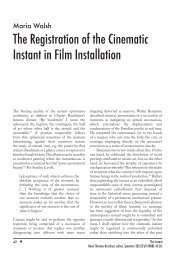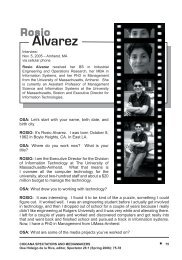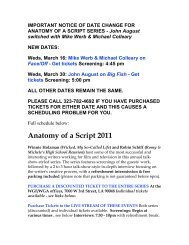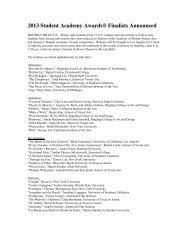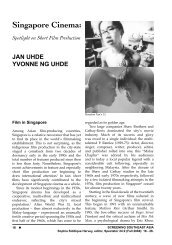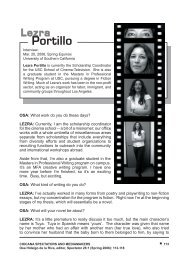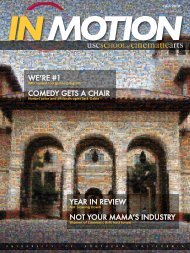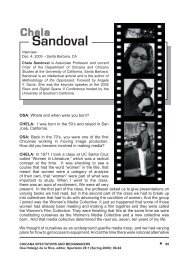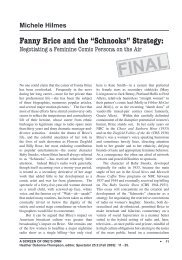IN MOTION (backup) V.3 - USC School of Cinematic Arts - University ...
IN MOTION (backup) V.3 - USC School of Cinematic Arts - University ...
IN MOTION (backup) V.3 - USC School of Cinematic Arts - University ...
Create successful ePaper yourself
Turn your PDF publications into a flip-book with our unique Google optimized e-Paper software.
Game On!<br />
(continued from page 1)<br />
The EA Interactive Entertainment Program, which is a track<br />
in the three-year Master <strong>of</strong> Fine <strong>Arts</strong> degree, supports new<br />
courses to help students become pr<strong>of</strong>icient in scriptwriting,<br />
as well as visual and audio effects, which are then used to<br />
create compelling interactive experiences with cinematic<br />
qualities for a variety <strong>of</strong> game playing populations.<br />
An integral part <strong>of</strong> the interactive entertainment program is<br />
the Electronic <strong>Arts</strong> Game Innovation Lab, based in the<br />
Zemeckis Center for Digital <strong>Arts</strong>. This state-<strong>of</strong>-the-art facility<br />
serves as a research space and think tank where new concepts<br />
in game design, play, and usability are developed,<br />
prototyped and play-tested. The room is equipped with an<br />
array <strong>of</strong> technologies, from PCs sporting high-end graphics<br />
cards, to a usability room set up with one-way mirrors and<br />
video cameras that allow researchers and developers to monitor<br />
how players interact with various games. Students, faculty,<br />
and visiting scholars in the lab are investigating a broad<br />
range <strong>of</strong> subjects, such as scalable networked virtual environments,<br />
multi-platform gaming environments, and ubiquitous<br />
gaming. Through their work, lab users are pushing<br />
games beyond their currently defined genres, markets, and<br />
play patterns, creating a body <strong>of</strong> knowledge about players,<br />
games, and game playing that provides a launching pad for<br />
the next generation <strong>of</strong> s<strong>of</strong>tware and hardware.<br />
Beyond the lab, EA support is aiding in the formation <strong>of</strong> an<br />
intra-<strong>USC</strong> gaming community that brings together creative<br />
and technical expertise in cinema-television, the arts, and<br />
technical sciences, and provides students with invaluable<br />
real-world experience through internships and work-study<br />
programs at EA, including the company’s newest Los<br />
Angeles studio.<br />
Pr<strong>of</strong>essor Perry Hoberman (left) helps student Todd Furmanski<br />
program a BASIC stamp chip, which enables a computer to<br />
read various types <strong>of</strong> sensors (light, motion, etc.).<br />
The EA Endowed Faculty Chair — which brings some <strong>of</strong><br />
the gaming industry’s top talent to teach at <strong>USC</strong> — elevates<br />
the field into the ranks <strong>of</strong> other pr<strong>of</strong>essions, such as law and<br />
medicine, and draws the top student candidates from home<br />
and abroad to learn one-on-one from these masters. The EA<br />
chair is one <strong>of</strong> six newly created endowed positions that the<br />
<strong>School</strong> installed this fall. Together they join an impressive<br />
roster <strong>of</strong> funded seats at the <strong>School</strong>, including the Alma and<br />
Alfred Hitchcock Endowed Chair, the Mary Pickford<br />
Pr<strong>of</strong>essorship, the Steven J. Ross/Time Warner Dean’s Chair,<br />
the Fran and Ray Stark Endowed Chair, and the Hugh M.<br />
Hefner Chair.<br />
Playing It Smart<br />
Interview with Scott Fisher, chair<br />
<strong>of</strong> the Division <strong>of</strong> Interactive Media<br />
Arriving at the <strong>School</strong> in 2002, Scott Fisher brings a wealth <strong>of</strong> experience as a media artist and interaction<br />
designer whose work focuses primarily on interactive environments and technologies <strong>of</strong> presence.<br />
Well known for his pioneering work in the field <strong>of</strong> Virtual Reality at NASA, Fisher’s media industry<br />
experience includes Atari, Paramount, and his own companies Telepresence Research and Telepresence<br />
Media. Fisher is a graduate <strong>of</strong> MIT’s Architecture Machine Group (now Media Lab); has taught at MIT,<br />
UCLA and UCSD; and served as project pr<strong>of</strong>essor and director <strong>of</strong> the Environmental Media Project for<br />
Keio <strong>University</strong> at Shonan Fujisawa, Japan.<br />
Scott Fisher<br />
Q: What is the importance <strong>of</strong> interactive media, or, put more directly, why should<br />
people take this division seriously?<br />
Fisher: The short response to that question is that interactive entertainment is most likely going to be the<br />
dominant form <strong>of</strong> entertainment in the 21st century. The most common example is what’s happening with<br />
the video game industry where the revenues from that are now competing with film box <strong>of</strong>fice revenues.<br />
That said, in the longer term there are a couple different aspects in terms <strong>of</strong> where we are in development.<br />
The technologies that are the underpinnings <strong>of</strong> interactive media, <strong>of</strong> interactive entertainment, are now<br />
coming to the point where they can easily compete with other home consumer devices. PlayStation, for<br />
example, at $149, is approaching the quality <strong>of</strong> graphics machines that five or six years ago we were paying<br />
a couple hundred thousand dollars for. Those kinds <strong>of</strong> developments are really crucial. Perhaps more important,<br />
beyond the technology availability and cost effectiveness is the type <strong>of</strong> experience people have become<br />
used to. People are accustomed to using the Web, using a lot interactivity in their day-to-day activities, and<br />
we see students coming in expecting to have much more access and availability <strong>of</strong> interactive coursework.<br />
We in the division believe that this will only grow, and that this process will evolve into a very major new<br />
set <strong>of</strong> media to provide interactive experiences.<br />
Q: Where do you see the division in terms <strong>of</strong> defining how we learn, teach, and collaborate<br />
with one another?<br />
Fisher: Even though we call the mission <strong>of</strong> the division interactive entertainment, a huge area <strong>of</strong> interest<br />
and importance for us is in educational applications in all <strong>of</strong> the different media that I have been talking<br />
about, but particularly games. We see that crossing over very quickly and very effectively. For example,<br />
a few months ago I went to a seminar around E3, which is the largest game convention in the world.<br />
This workshop was specifically focused on using games for education. Representatives from all the<br />
major universities were present and witnessed demonstrations <strong>of</strong> crossovers, <strong>of</strong> using game scenarios for<br />
educational applications.<br />
Q: What are the plans for expanding the reach <strong>of</strong> the program?<br />
Fisher: We have a minor in game design in collaboration with the Viterbi <strong>School</strong> <strong>of</strong> Engineering, and<br />
because <strong>of</strong> that we’re looking at undergraduate numbers growing substantially in our undergraduate game<br />
design and interactive media introduction classes. Depending on how that goes, we would very much like<br />
to grow this into an undergraduate program in addition to the MFA program.<br />
Q: Interactive media studies programs are cropping up around the nation. Why<br />
should prospective students choose <strong>USC</strong> over some other place?<br />
Fisher: It’s true, there are plenty <strong>of</strong> other game programs out there. There are vocational schools, there are<br />
schools like Carnegie Mellon, the <strong>University</strong> <strong>of</strong> Washington, and Stanford, but I think the particular mix <strong>of</strong><br />
things we have to <strong>of</strong>fer is just unbeatable. Carnegie Mellon has a two-year program, but it’s much more oriented<br />
around the technology and tool-building end <strong>of</strong> things. We’re focused much more on the storytelling<br />
and experience-design aspect <strong>of</strong> it. And that’s really the key thing that’s going to make any new technology<br />
work in the public’s eye — it’s not the technology itself, it’s what you do with it. We also have a mix <strong>of</strong><br />
backgrounds applying. We have computer science students, we have a lot <strong>of</strong> design students, we have<br />
artists, we have philosophers. It’s a very good mix that I think is critical to make something like this work,<br />
because eventually the teams that these guys will end up putting together will mirror that same mix.<br />
fall 2004 in motion | 11




